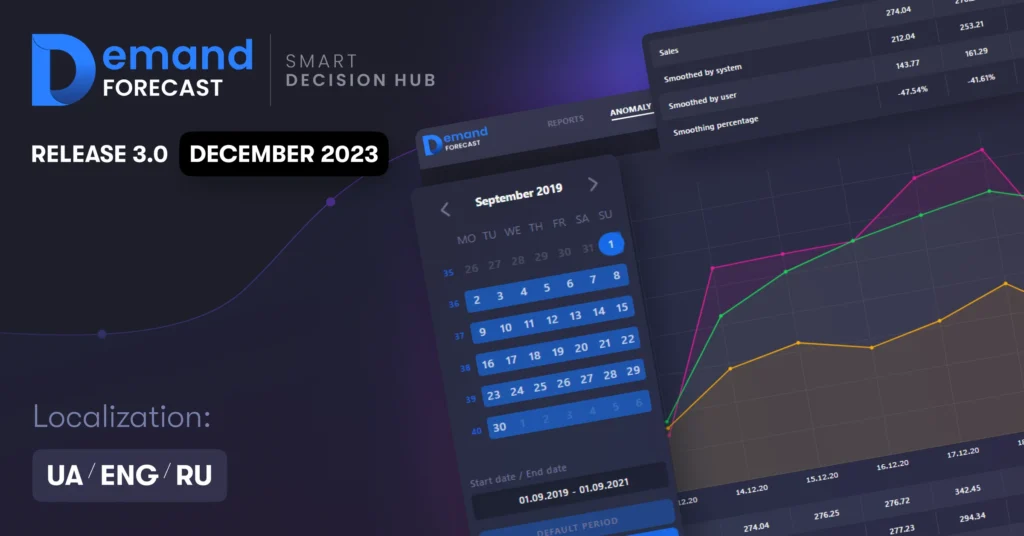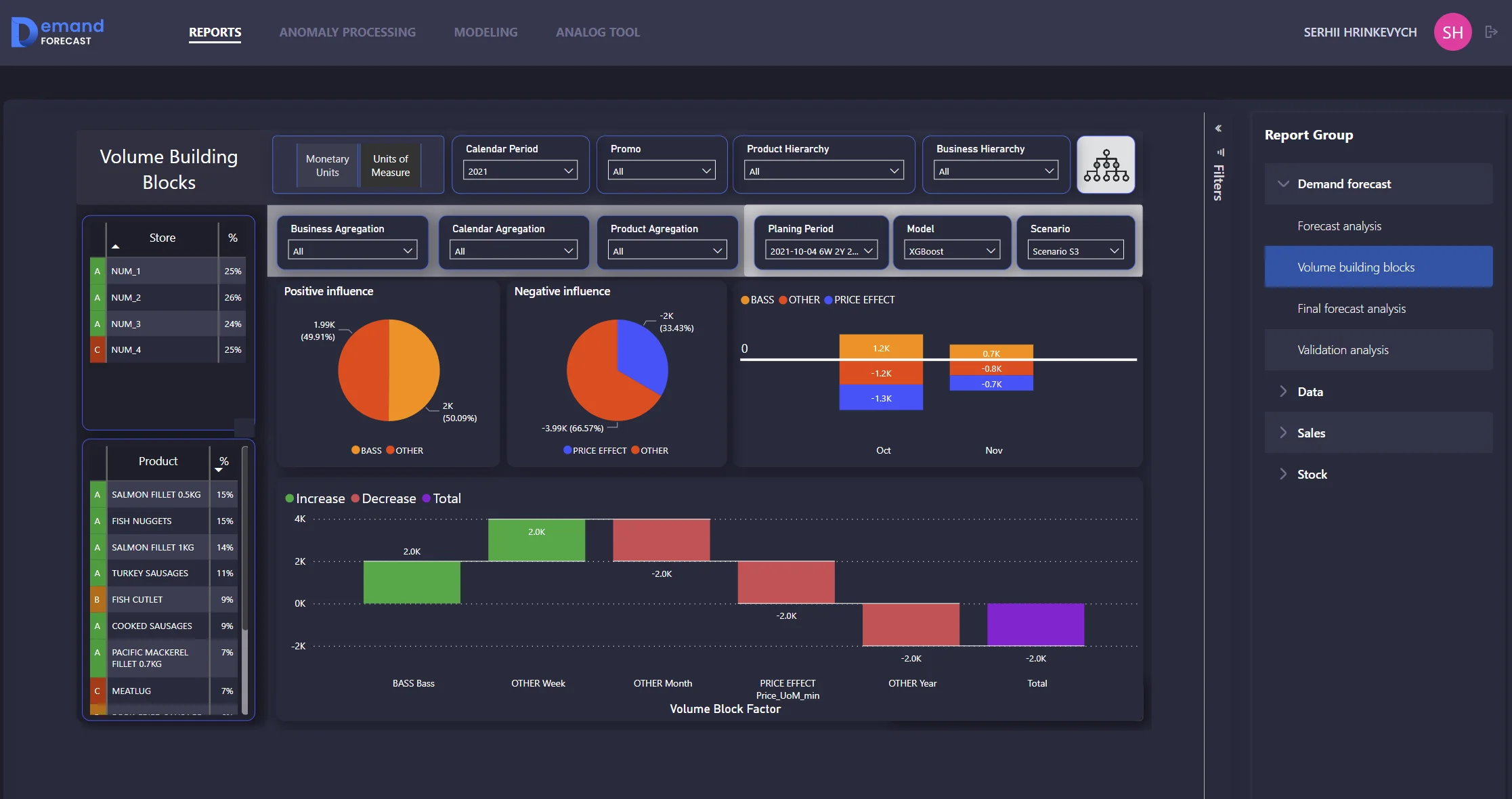06 Dec 2023 9 MIN READ
Building a forecast has become even easier with the new SMART Demand Forecast release 3.0

Improving forecasting accuracy plays a crucial role in contributing to strategic business planning by helping to understand market trends, customer demand, and customer needs. This allows you to effectively manage inventory and logistics, minimizing unnecessary costs and risks of shortages.
Modern forecasting systems, such as SMART Demand Forecast, use multivariate models and analyze a huge amount of data to predict changes in demand. To do this more effectively, the system must be constantly improved.
In this update, we have done a lot of work to optimize all system processes and the interface to ensure easy use of the solution, data download, table viewing, and analytics. We also added new key functionalities:
- data anomaly detection and processing;
- the ability to decompose the forecast into key components;
- forecast calculation factors: external factors (natural phenomena, force majeure, exchange rate fluctuations, etc.) and competitors’ influence;
- forecasting model – XGBoost;
- Power BI reports and much more.
Read more about all system updates in the article below.
The definition of technical statuses and their display in the interface has been updated
Changes to the interface and statuses make it easy to navigate the system and quickly adapt it to changes in company processes. This makes SMART Demand Forecast a more flexible solution and helps new users learn, as the program is intuitive and meets modern information presentation standards.
Dynamic adaptation to changes in the number of product levels has been added
The workflows associated with building a demand forecast become easier due to the flexibility in managing products in the assortment. The system is now able to quickly adapt to changes in the product structure, making it much more convenient to use in everyday work.
The update allows you to easily scale and customize the system to meet your current needs with less time and human resources.
Improved visualization of system processes and data display
Thanks to optimized algorithms and improved data processing, process visualization has become faster and smoother. Now the information on the screen reflects what is happening during system operation more accurately. It is easier for the user to see the stages of data processing, so interaction with the solution will be as comfortable and understandable as possible, even for new employees.
Optimized recovery in case of connection loss
For the SMART Demand Forecast team, one of the most important areas is providing customers with a stable performance of the solution. The system now monitors processes in real time, so if the Internet connection suddenly goes down, updated recovery strategies are automatically launched.
The work process is now smoother, despite external factors. Now you don’t have to worry about losing the data you’ve been working with. This ensures not only high-quality work in technical terms but also reduces employee stress and minimizes unplanned interruptions in work.
The ability to process anomalies has been added
The issues of finding and processing anomalous data are always in the first place for systems that work with large amounts of data and use artificial intelligence. SMART Demand Forecast is no exception, but thanks to the accumulated expertise, the ability to detect anomalies in historical sales, smooth them, and correct them has been introduced.

Synchronous scrolling of anomaly tables and graphs has been added
When working in SMART Demand Forecast, you can simultaneously scroll and compare information in tables and anomaly graphs. This feature provides a more convenient and efficient way to analyze information that will affect the demand forecast. Now users can identify important patterns and anomalies in the data faster and form an analytical basis for further decisions in supply chain management.
The ability to decompose the forecast into component parts has been added
The key elements that make up the total volume of the forecast are the blocks of component parts. Their decomposition helps to more accurately predict future trends, identify key drivers of change, and develop more effective resource management and planning strategies.
The report “Component parts blocks” was created in the system. It allows you to quickly analyze which factors influenced the forecast up or down, make strategic decisions on deliveries and promotions, etc. based on these factors.

A new interface for importing and exporting analog tables has been implemented
Continuous improvement of the system’s appearance is one of the important areas of development for SMART Demand Forecast. Therefore, this system update includes the integration of a new interface for importing and exporting analog tables.
Thanks to the simple and clear display of information, users can interact with the system faster. This reduces the amount of time and effort required to perform operational tasks.
A new range component has been added for anomaly search settings
With this feature, users can easily set the contamination level for the Isolation Forest search method through an intuitive interface, simplifying the process of identifying anomalies in data. This increases the productivity of the system and enables the team to prepare high-quality analytical reports.
CI/CD processes have been optimized
As a part of the 3.0 release, CI/CD processes have been modified, which significantly increases the speed of deployment and quality control of product delivery during development, testing, and delivery to the client.
Although this is not obvious to users, it is an important aspect of the work, as it helps to quickly and efficiently implement new features and continuously improve the system in the future.
The ability to use the calendar during modeling has been expanded
The updated interface of the SMART Demand Forecast calendar ensures its effective use, allowing you to quickly obtain the necessary information and view data at different levels of aggregation. In addition, the ability to quickly select a date to open the planning period has been added.
The approach to forecasting for new products has been updated.
New products in the assortment make it difficult to build a demand forecast. The standard logic of providing analogs for forecasting works, however, there are situations when you need to set a large number of analogs for hundreds or thousands of products. Now this is possible without specifying an analog but based on average sales in the category.
A new machine learning model, XGBoost, has been added
XGBoost is one of the most successful machine learning models (extreme gradient boosting) and the winner of many Kaggle competitions in the field of forecasting and regression tasks.
By adding this model to SMART Demand Forecast, the company gets the opportunity to experiment with different forecasting tools and choose the most effective ones.
TFT model performance has been optimized
The TFT (Temporal Fusion Transformation) model implemented in release 2.0 has been refactored and improved in terms of performance and accuracy. First of all, we improved its accuracy, which makes it possible to produce better forecasts and thus increase business performance.
New factors have been implemented: Bass diffusion, influence of competitors and external factors
The Bass diffusion factor is based on research conducted for the previous release. It helps to identify patterns for products with a short history. Experiments have shown that this factor is very useful for forecasting all products, as it helps to take a more comprehensive approach to building a forecast.
It is also possible to take into account such important factors as the influence of competitors if the relevant data is available.
We continue to work on taking into account external factors of demand formation. It is now possible to take into account economic factors.
- A new analytical data model has been created
In release 3.0, we optimized and created a new concept of analytical reporting:- The existing Power BI reports were adapted;
The “Compensated Sales” report allows the user to analyze the facts of shortages of goods in certain stores and see how much revenue was lost. It helps to reduce losses in the future.
The “Sales Analysis” report allows the user to work with the actual sales history, compare different periods, and see trends.
The “Forecast Analysis” report compares actual sales data with the final forecast for previous calendar periods and evaluates its accuracy. - There are 5 new Power BI reports that have been added:
The “ABC-XYZ Analysis” report displays metrics by product and store categorization, depending on sales volumes and volatility.
The “Stock balances analysis” report shows how long certain products will last in certain stores given the forecasted demand. This allows you to make decisions about planning the supply of goods to stores and determining the optimal Safety Stock.
The “Product Availability Analysis” report shows for which products in which stores there were shortages during the historical period, which allows you to identify shortages in supplies for more efficient planning.
The “Validation Analysis” report has been updated. Now it allows you to analyze how well the validation data set of the forecast coincides with actual sales. This allows you to evaluate the accuracy of the forecast results and make a decision on the further use of the trained model.
The “Final Forecast Analysis” report allows you to compare the scenarios of the created forecasts with each other and make a decision on finalization by selecting one of the scenarios. - a unified design concept was developed;
- the main metrics for analysis were agreed upon.
- The existing Power BI reports were adapted;
Now it is possible to analyze and visualize both the current state of the business (actual sales and inventory) and the results of the DF application (visualization of the forecast and its accuracy metrics).
For more information about SMART business solutions and services, please call +38 (044) 585-35-50 or submit your request.
